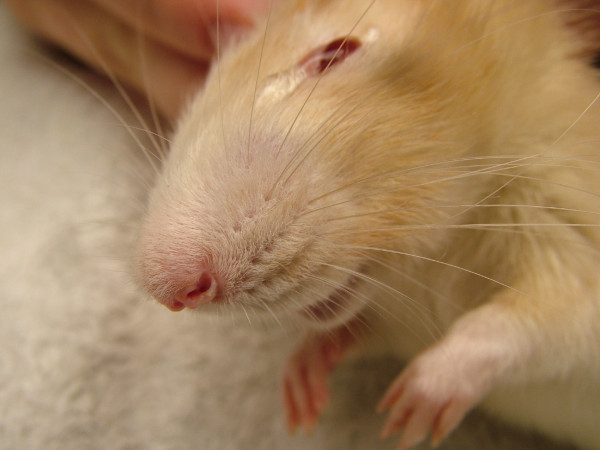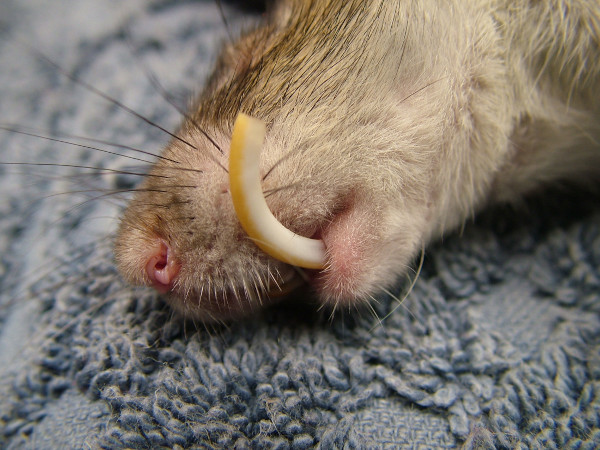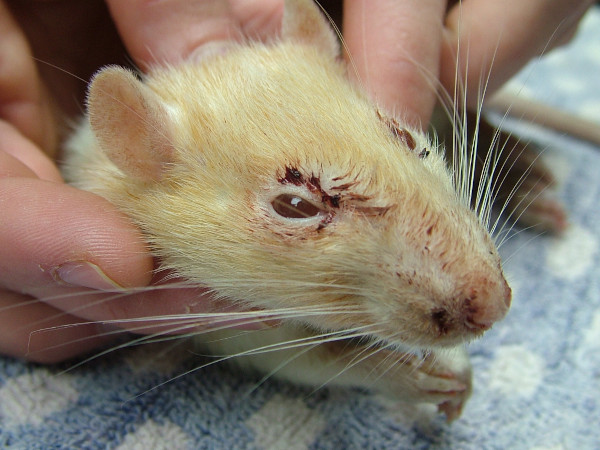Dental disease
Overgrown incisor teeth (particular the lower incisors) are the most common oral problem in rats as their incisors continuously grow. With only the incisors continuously growing in rats, dental disease affecting the cheek teeth is much less common than in some other rodents such as guinea pigs whose molars also grow continuously.
Providing a good quality diet and enrichment items for rats to gnaw on can help to avoid overgrown incisor teeth.
Overgrown incisor teeth are sometimes the result of malocclusion (misalignment of the top and bottom teeth, either present since birth or because of trauma).
Affected animals may be off their food, slobbering and drooling, and have weight loss. There may be swelling on the face, and this might be painful, as evidenced by them rubbing at their face or wiping it against the enclosure.
Speak to your veterinarian about treatment, which requires trimming the teeth every 4-5 weeks using a high-speed dental burr (it is recommended that this is done by a veterinarian under anaesthesia to avoid injury to the rat). Clipping with nail clippers can result in shattering of the teeth or longitudinal splits. The affected tooth (or teeth) can be extracted, but this is very difficult to do (the root is much longer than the tooth).


Mammary tumours in rats
Mammary tumours are the most common cancer in rats. They can occur over a large area as mammary tissue is very widespread in rats – see the diagrams below. The tumours can be very fast growing, doubling in size within two weeks or less.

The tumours can usually be surgically removed successfully in rats since most mammary tumours do not metastasise (spread to other organs). However, recurrence in other previously unaffected mammary tissue is common, requiring more surgery. Better results are achieved if the tumours are removed when they are small.
Desexing of rats is highly recommended to help reduce the incidence of mammary neoplasia as mammary tumours appear to have a hormonal cause in rats. The most benefit in terms of mammary tumour risk reduction is achieved by spaying rats before they are three months old but spaying between four and seven months will also help reduce the risk, just not as significantly.
Chronic respiratory disease in rats
Upper or lower respiratory tract diseases are the most common health problem in rats. Clinical signs are variable and include:
- Laboured, rapid breathing
- Sniffling and sneezing
- Red nasal discharge and clicking sounds. A term often used is ‘snicking’.
- Red tears (chromodacryorrhoea)
- Head tilt
- Reduced grooming
- Weight loss

The cause of chronic respiratory disease (CRD) in rats is multifactorial.
- Irritation of the airways with dust, aromatic oils (pine, cedar, etc), and ammonia (from urine) damages the lining of the respiratory tract.
- This lining is then invaded by Mycoplasma, a type of bacteria.
- The Mycoplasma causes even more damage, allowing infection with other bacteria.
The result is that the lining of the airways becomes thick and rigid, and a very tenacious mucus fills the airways.
By the time the problem is noticed, the changes in the lung are permanent and the infection cannot be eliminated. Treatment with antibiotics, bronchodilators, and steam therapy can improve things for a while, but this infection always comes back.
Treatment may be lifelong for severe cases. Some animals may survive for up to a few years with repeated treatment, but eventually the disease is terminal.
Chromodacryorrhea (red tears)
Chromodacryorrhea, or red tears usually occurs in rats who are stressed or diseased. It results from the Harderian glands located behind the rat’s eyes producing porphyrin pigments, which cause the tears to become a red colour. This can appear like the rat is bleeding from their eyes. The red tears may also dry and crust around the eyes and nostrils and look like dried blood.
It is important that rats with this condition are taken promptly to a veterinarian as it is often an indication of chronic underlying disease and stress which needs to be addressed.
Skin issues
Parasitic skin infections, particularly with fur mites, are common in rats and may cause itchiness, fur loss, self-traumatisation, and even anaemia, debilitation, and death in severe cases. For more information on fur mites and other parasites in rats, see this article.
References
Frohlich J (2020) Rats and mice. In: Quesenberry KE, Orcutt CJ, Mans C, Carpenter JW (eds) Ferrets, rabbits and rodents, 4th ed. W.B. Saunders, pp 345–367
